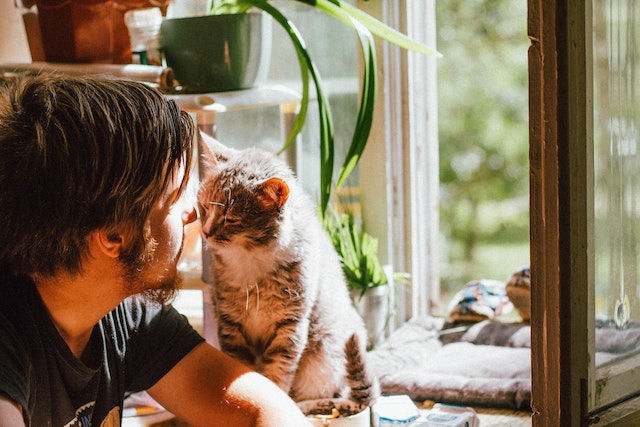What to Do When Your Cat Isn’t Eating?

For cat parents, there’s nothing more satisfying than seeing their beloved feline enjoying their food with gusto. However, sometimes, cats can be quite the opposite. They might seem uninterested in eating or turn their nose up at the same food they usually enjoy.
What could be the reason behind this behaviour?
Just like humans, cats’ appetites can change due to various factors. They can be influenced by factors such as minor illnesses, psychological stress, environmental comfort, the presence of other cats, and the temperature of the food. Therefore, occasional low appetite in cats is not usually a problem.
However, if your cat consistently has a poor appetite, it’s time to carefully consider the situation!If your cat’s appetite has been consistently low, it’s important to identify the cause.
External environmental factors can be managed, but if it’s an internal issue, you need to be cautious. So, cat owners, start by determining if there’s an underlying health issue. Usually, a sick cat shows one or more of the following symptoms:Redness and discharge in the eyes, vomiting, diarrhoea, runny nose, nasal congestion, excessive drooling, oral inflammation, lethargy, weakness in limbs, etc. If your cat exhibits more than one of these symptoms, it’s likely that the loss of appetite is due to an illness, and appropriate treatment is necessary.
If non-medical factors are causing appetite loss, you can try the following methods to stimulate your cat’s appetite! These methods are diverse, and there’s bound to be one suitable for your cat!
What do you do if your cat won’t eat?
Adjust Meal Frequency
If your cat used to have unrestricted access to food, you can increase their appetite by changing the meal frequency. For kittens under 5 months old, whose appetites are generally good, you can feed them 6-8 times a day with small portions.
For cats aged 5-10 months, their appetite often diminishes during puberty, so you can feed them 4-6 times a day. Adult cats usually have stable appetites and can be fed 3-4 times a day. For senior cats, if their appetite isn’t stable, find the cause before deciding.
Change Food Type
Cats are known to primarily eat canned food, dry kibble, wet food, meat, and freeze-dried products. Cat owners often worry about their cat’s fluctuating appetite.
Sometimes, it’s not that the cat doesn’t want to eat; it’s just that the food might not be appealing enough. Therefore, changing the food type occasionally can also improve your cat’s appetite. The simplest way is to switch to a different brand of cat food.
Some cats might prefer meals with a fish flavour, while others might enjoy meat. Observing your cat’s preferences can help you decide! From our experience, boiled chicken breast and egg yolks are always a hit with cats!
Adjust Food Temperature
Sometimes, the temperature of the food can also affect a cat’s appetite. Warm food (around 37°C) is more aromatic and can quickly stimulate a cat’s desire to eat. Especially when a cat has a stuffy nose, warm food and warm water are essential!
Sufficient Playtime
Long periods of rest are usually not conducive to generating appetite. Just like humans, cats need sufficient playtime to feel a slight hunger. The easiest method is to play with your cat using a feather wand or a laser pointer for 15-20 minutes. After expending energy, the cat’s metabolism will increase, leading to an evident increase in appetite!
Adequate Vitamin B
Cats need proper amounts of vitamin B to maintain their health. Otherwise, various issues can arise, such as dermatitis, stomatitis, and more. Cat owners wouldn’t want to see that! Therefore, regularly giving your cat cyanocobalamin (vitamin B12) not only promotes their health but also maintains their appetite. Vitamin B can be administered through injection or oral consumption, depending on your cat’s characteristics.
Psychological Comfort
Cat owners undoubtedly care deeply for their cats. When your cat seems uninterested in food for no apparent reason, a little comfort and encouragement can help. You can stroke your cat or even hand-feed them to show your care. Cats feel the love and will likely be more eager to eat.
Improve the Dining Environment
Some cats are relatively particular. They prefer a quiet, clean environment to eat without any disruptions from other cats. Therefore, cat owners might consider creating a more comfortable setting for their cats to dine.
Special Foods in Moderation
Occasionally, a cat might have a weak constitution and need to consume high-energy foods to stimulate their appetite. You can prepare such foods for your cat in advance.In conclusion, a cat’s appetite can be influenced by multiple factors. Therefore, you should first rule out underlying illnesses and then try these eight methods to stimulate your cat’s appetite.
Whether it’s changing food brands, adjusting food temperature, or engaging your cat in play, all these efforts aim to provide a satisfying dining experience for your cat while keeping them mentally and physically content – the ultimate aspiration of us cat owners!
Of course, if these methods don’t seem to help your cat eat, it’s time to contact a veterinarian. After all, if a cat goes 24 hours without eating, it can lead to a complete breakdown of bodily functions. So, cat owners, pay careful attention!
